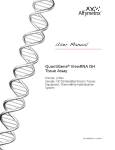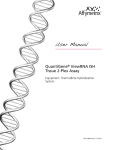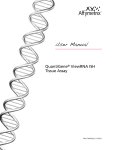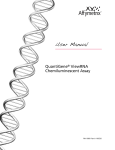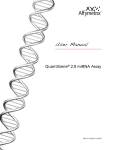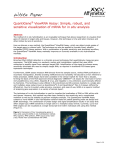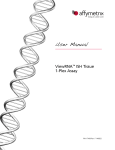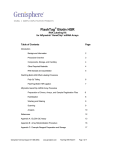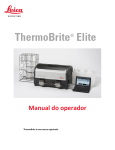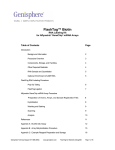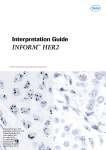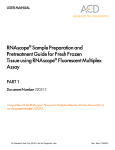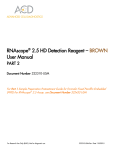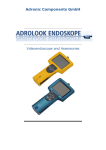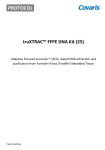Download QuantiGene® ViewRNA For FFPE Samples
Transcript
QuantiGene ViewRNA For FFPE Samples User Manual P/N 17400 Rev A 090708 DRAFT July 8, 2009 10:47 pm QGViewRNATtile.fm ® Panomics, Inc. QuantiGene ViewRNA For FFPE Samples User Manual Copyright © Copyright 2009, Panomics, Inc. All rights reserved. Trademarks QuantiGene is a registered trademark exclusively licensed to Panomics, Inc. All other trademarks belong to their respective owners. Citing QuantiGene ViewRNA in Publications When describing a procedure for publication using this product, please refer to it as the QuantiGene ViewRNA assay. If a paper cites a QuantiGene ViewRNA product and is published in a research journal, the lead author(s) may receive a travel stipend for use at a technology conference or tradeshow by sending a copy of the paper to our technical support group at [email protected] or via fax at (510) 818-2610. Disclaimer Panomics, Inc. reserves the right to change its products and services at any time to incorporate technological developments. This manual is subject to change without notice. Although this manual has been prepared with every precaution to ensure accuracy, Panomics, Inc. assumes no liability for any errors or omissions, nor for any damages resulting from the application or use of this information. Contacting Panomics U.S Corporate Headquarters Panomics, Inc.(now a part of Affymetrix) 6519 Dumbarton Circle Fremont, CA 94555 Toll Free: 877 PANOMICS (1.877.726.6642) Direct: 1.510.818.2600 Fax: 1.510.818.2610 Email: [email protected] Email: [email protected] Email: [email protected] European Headquarters Panomics Srl Via Sardegna 1 20060 Vignate-Milano (Italy) Tel: +39.02.95.360.250 Fax: +39.02.360.992 Email: [email protected] Email: [email protected] Email: [email protected] Asia Pacific Headquarters Panomics, Inc. 16F Gemdale Plaza Tower A, No. 91 Jiango Road, Beijing 100022 P.R. China Tel: +86.10.59208157 Fax: +86.10.59208111 Email: [email protected] Email: [email protected] Email: [email protected] DRAFT July 8, 2009 10:47 pm QGViewRNATtile.fm Contents Section I: Introduction . . . . . . . . . . . . . . . . . . . . . . . . . . . . . . . . . . . . . . . . . . . . . . . . . . 1 About This Manual . . . . . . . . . . . . . . . . . . . . . . . . . . . . . . . . . . . . . . . . . . . . . . . . 1 QuantiGene ViewRNA Assay Basics . . . . . . . . . . . . . . . . . . . . . . . . . . . . . . . . . . 1 How It Works . . . . . . . . . . . . . . . . . . . . . . . . . . . . . . . . . . . . . . . . . . . . . . . . . . . . 1 Section II: Required Materials . . . . . . . . . . . . . . . . . . . . . . . . . . . . . . . . . . . . . . . . . . . . 2 QuantiGene ViewRNA FFPE Sample Optimization Kit (Optional) . . . . . . . . . . . . 2 QuantiGene ViewRNA Assay Kit for FFPE Samples . . . . . . . . . . . . . . . . . . . . . . 2 QuantiGene ViewRNA Chromogenic Signal Amplification Kit . . . . . . . . . . . . . . . 2 QuantiGene ViewRNA Assay Probe Sets . . . . . . . . . . . . . . . . . . . . . . . . . . . . . . 3 Optional QuantiGene ViewRNA FFPE Positive Control Kit (Rat Kidney). . . . . . . 3 Required Materials Not Provided . . . . . . . . . . . . . . . . . . . . . . . . . . . . . . . . . . . . . 3 Section III: Recommendations for Experimental Design and Assay Optimization . . . . . 5 Overview . . . . . . . . . . . . . . . . . . . . . . . . . . . . . . . . . . . . . . . . . . . . . . . . . . . . . . . 5 Optimization experiment . . . . . . . . . . . . . . . . . . . . . . . . . . . . . . . . . . . . . . . . . . . 5 Expected Results . . . . . . . . . . . . . . . . . . . . . . . . . . . . . . . . . . . . . . . . . . . . . . . . . 5 Section IV: Assay Workflow . . . . . . . . . . . . . . . . . . . . . . . . . . . . . . . . . . . . . . . . . . . . . . 6 Section V: Sample Pretreatment . . . . . . . . . . . . . . . . . . . . . . . . . . . . . . . . . . . . . . . . . . 7 Overview . . . . . . . . . . . . . . . . . . . . . . . . . . . . . . . . . . . . . . . . . . . . . . . . . . . . . . . 7 Important Procedural Note . . . . . . . . . . . . . . . . . . . . . . . . . . . . . . . . . . . . . . . . . . 7 Before You Start . . . . . . . . . . . . . . . . . . . . . . . . . . . . . . . . . . . . . . . . . . . . . . . . . . 7 Procedure. . . . . . . . . . . . . . . . . . . . . . . . . . . . . . . . . . . . . . . . . . . . . . . . . . . . . . . 8 Section VI: In Situ Hybridization Procedure . . . . . . . . . . . . . . . . . . . . . . . . . . . . . . . . . 10 Overview . . . . . . . . . . . . . . . . . . . . . . . . . . . . . . . . . . . . . . . . . . . . . . . . . . . . . . 10 Important Procedural Notes . . . . . . . . . . . . . . . . . . . . . . . . . . . . . . . . . . . . . . . . 10 Before You Start . . . . . . . . . . . . . . . . . . . . . . . . . . . . . . . . . . . . . . . . . . . . . . . . . 10 Procedure. . . . . . . . . . . . . . . . . . . . . . . . . . . . . . . . . . . . . . . . . . . . . . . . . . . . . . .11 Section VII: Troubleshooting . . . . . . . . . . . . . . . . . . . . . . . . . . . . . . . . . . . . . . . . . . . . 19 Troubleshooting No or Weak Signals . . . . . . . . . . . . . . . . . . . . . . . . . . . . . . . . . 19 High Background on the Tissue Section . . . . . . . . . . . . . . . . . . . . . . . . . . . . . . 19 High Background on Slide . . . . . . . . . . . . . . . . . . . . . . . . . . . . . . . . . . . . . . . . . 20 Hematoxylin Staining is too Strong. . . . . . . . . . . . . . . . . . . . . . . . . . . . . . . . . . . 20 Section VIII: Rat Kidney FFPE Tissue Example . . . . . . . . . . . . . . . . . . . . . . . . . . . . . 21 QuantiGene ViewRNA FFPE User Manual iii Table of Contents iv QuantiGene ViewRNA FFPE User Manual Section I: Introduction Section I: Introduction About This Manual The QuantiGene ViewRNA Reagent System is an in situ hybridization method for visualization of target RNA within individual cells. This manual provides complete instructions for performing QuantiGene ViewRNA assays using formalin-fixed paraffin-embedded (FFPE) samples, 4-6 µm sections and 16-24 hours fixation. QuantiGene The QuantiGene ViewRNA assay for FFPE samples is a novel RNA in situ ViewRNA Assay hybridization product, based on patent-pending Probe Set design and proprietary Basics signal amplification technology, that offers 10 copy RNA sensitivity in individual cells. Signal amplification is predicated on specific hybridization of adjacent Probe Set oligonucleotides to a target RNA (see How It Works below), resulting in excellent signal-to-noise ratios. How It Works PreAmp1 FFPE tissue section Amp1 LP-AP Target Step 1: Prepare Sample. FFPE tissue samples, fixed for 16-24 hours at room temperature (RT), are sectioned to 4-6 µm thickness and attached to a positively-charged slide. FFPE tissue sections are treated with a Pretreatment Solution followed by Protease digestion to allow target accessibility. Step 2: Hybridize Probe Sets. A gene-specific Probe Set hybridizes to the target mRNA. For clarity, only single oligonucleotide pairs are shown. However, a typical Probe Set contains 10 or more oligonucleotide pairs. Step 3: Amplify Signal. A Pre-Amplifier (PreAmp) molecule hybridizes to each pair of oligonucleotides, then multiple Amplifier (Amp) molecules hybridize to each PreAmp. Finally, multiple Label Probe oligonucleotides conjugated to alkaline phosphatase (LP-AP) hybridize to each Amp. Following the addition of the Fast Red Substrate, alkaline phosphatase breaks down the substrate to form a precipitate (punctated dots) that indicates the presence of the target RNA molecule. Step 4: Image. Target mRNA is visualized using standard brightfield microscopy and cell nuclei can be identified by the Hematoxylin counterstain. QuantiGene ViewRNA FFPE User Manual 1 Section II: Required Materials Section II: Required Materials QuantiGene ViewRNA FFPE Sample Optimization Kit (Optional) For initial optimization of a new tissue, this optional, cost-effective, all-inclusive kit enables you to optimize assay conditions for up to 2 specific tissues. Once you have optimized the conditions, those conditions can be used to evaluate targets of interest using the QuantiGene ViewRNA Assay Kit for FFPE samples, Chromogenic Signal Amplification Kit, and QuantiGene ViewRNA Probe Sets. This kit is available for human (QV0100), mouse (QV0101), or rat (QV0102) samples only. Refer to the Product Insert for quantities of individual components supplied. Kits have a shelf life of 6 months from the date of delivery. QuantiGene ViewRNA Assay Kit for FFPE Samples The components of the QuantiGene ViewRNA Assay Kit for FFPE samples and their recommended storage conditions are listed below. QuantiGene ViewRNA Assay Kits for FFPE samples are available in two sizes: QV0050 and QV0051, sufficient for 24 or 96 assays, respectively. Each kit is configured for processing a minimum of 6 slides per experiment. Refer to the product insert for quantities of individual components supplied. Kits have a shelf life of 6 months from date of delivery. Component Description Storage 100X Pretreatment Solution Aqueous buffered solution 2-8 °C Proteasea Aqueous buffered solution 2-8 °C Hybridization Buffer A (Hyb A) Aqueous solution containing formamide and detergent 2-8 °C Hybridization Buffer B (Hyb B) Aqueous solution containing formamide and detergent 2-8 °C Hybridization Buffer C (Hyb C) Aqueous solution containing detergent 2-8 °C Wash Buffer Component 1 (Wash Comp 1) Aqueous solution containing detergent 15-30 °C Wash Buffer Component 2 (Wash Comp 2) Aqueous buffered solution 15-30 °C a. IMPORTANT! Do not freeze. QuantiGene ViewRNA Chromogenic Signal Amplification Kit 2 The components of the QuantiGene ViewRNA Chromogenic Signal Amplification Kit and their recommended storage conditions are listed below. This kit is available in 2 sizes: QV0200 and QV0201, sufficient for 24 or 96 assays, respectively. Each kit is configured for processing a minimum of 6 slides per experiment. Refer to the Product Insert for quantity of individual components supplied. Kits have a shelf life of 6 months from date of delivery. Component Description Storage PreAmplifier 1 (PreAmp1) DNA in aqueous buffered solution –20 °C Amplifier 1 (Amp1) DNA in aqueous buffered solution –20 °C AP Enhancer Solution Aqueous buffered solution 2-8 °C QuantiGene ViewRNA FFPE User Manual Section II: Required Materials Fast Red Tablets Red precipitating substrate for the detection of alkaline phosphatase activity 2-8 °C Naphthol Buffer Buffer required for preparation of Fast Red Substrate 2-8 °C Label Probe-AP (LP-AP) Alkaline Phosphatase-conjugated oligonucleotide in aqueous buffered solution 2-8 °C QuantiGene In addition to the Assay Kit for FFPE Samples and the Chromogenic Signal ViewRNA Assay Amplification Kit, QuantiGene ViewRNA TYPE 1 Probe Sets specific to your targets of Probe Sets interest must be purchased separately. Probe Sets are available in multiple sizes and should be stored at –20 °C. Refer to the Product Insert for more information. IMPORTANT QuantiGene ViewRNA TYPE 1 Probe Sets hybridize to the PreAmp1/Amp1/LP-AP signal amplification system, and can be used to visualize 10 RNA copies/cell in FFPE samples. Accessory Product Description Storage QuantiGene ViewRNA TYPE 1 Probe Set RNA-specific oligonucleotides for use with PreAmp1/Amp1/LP-AP –20 °C Visit www.panomics.com for the most up-to-date listing of available QuantiGene ViewRNA Probe Sets. If we do not yet offer a QuantiGene ViewRNA Probe Set for your RNA of interest, please submit the accession number (include version or provide gi number) or RNA sequence with your order, and we will design and synthesize it for you in approximately 2 weeks. Optional QuantiGene ViewRNA FFPE Positive Control Kit (Rat Kidney) The QuantiGene ViewRNA FFPE Positive Control Kit is designed for use with QuantiGene ViewRNA Assay Kit for FFPE Samples and QuantiGene ViewRNA Chromogenic Signal Amplification Kit. The kit includes 8, 4-6 µm-thick rat kidney FFPE sections attached to positively-charged slides as well as TYPE 1 Probe Set for rat Ubc. Refer to the Product Insert for the optimized conditions and recommendations for use. Required Materials Other materials required to perform the QuantiGene ViewRNA assay for FFPE Not Provided Samples that are not included in the Assay Kit for FFPE Samples or the Chromogenic Signal Amplification Kit are listed here. When specified, do not use alternate materials or suppliers. Table 1 All Sample Types Required Material Supplier Deionized Water (ddH2O) MLSa 95% Ethanol VWR 89015-512 10X PBS, pH 7.2-7.4 Bio-Rad Laboratories or Invitrogen 161-0780 70013-032 Gill's Hematoxylin I American Master Tech Scientific HXGHE1LT HistoClear National Diagnostics HS-202 QuantiGene ViewRNA FFPE User Manual Part Number 3 Section II: Required Materials Table 1 All Sample Types (continued) 37% Formaldehydeb Hydroxidec Fisher Scientific F79-1 VWR JT9726-5 20X SSC (used only for optional stop point in the procedure) Ambion AM9763 ImmEdge Hydrophobic Barrier Pen Vector Laboratories H4000 UltraMount DAKO S1964 Tissue Tek Staining Dish (clear color), 3 required American Master Tech Scientific LWT4457EA Tissue Tek Clearing Agent Dish (green color), 1 required American Master Tech Scientific LWT4456EA Tissue Tek Vertical 24 Slide Rack, 1 required American Master Tech Scientific LWSRA24 Coplin Jar, two 40-50 mL size MLS 1000 mL Glass Beaker MLS Cover Glass, 22 mm x 30 mm (not required if using optional tissue culture incubator) Fisher Scientific 12-530A ThermoBrite Hybridization Chamber, (holds up to 12 slides) Abbot Molecular 07J91-010 (110V) Humidifying Strips Abbot Molecular 30-144115 Isotemp Hot Plate Fisher Scientific 11-300-49SHP (120V) 27-30% Ammonium 07J91-020 (240V) 11-302-49SHP (230V) Temperature/humidity meter (optional if using tissue culture incubator) Fisher-Scientific 11-661-19 Optional. Tissue culture incubator, 40 °C without CO2 and 80-90% humidity for processing 12 or more slides per experiment. Napco 51201082 VWR 9150860 Optional. Aluminum slide rack for use in tissue culture incubator. VWR 100493380 Optional. Incubator or oven utilizing horizontal airflow and capable of maintaining 80 °C. Panomics QS0700, QS0701 (120V) or QS0710, QS0711 (220V) Bright Field Microscope MLS Water Bath capable of maintaining 40 +/- 1 °C MLS a. MLS = Major Laboratory Supplier b. WARNING! Formaldehyde is a poison and irritant. Avoid contact with skin and mucous membranes. c. WARNING! Highly volatile. Use in fume hood. 4 QuantiGene ViewRNA FFPE User Manual Section III: Recommendations for Experimental Design and Assay Optimization Section III: Recommendations for Experimental Design and Assay Optimization Overview In this section, we provide recommendations for identifying optimal pretreatment condition for the FFPE tissue in situ hybridization. One optimization experiment is required for each tissue type of interest. Because the quality of FFPE blocks vary, depending on their source, optimization is required. We recommend preparing the FFPE blocks the same way you prepare the tissue sections you plan to use. Optimization You will need to prepare ten, 4-6 µm thick FFPE tissue sections from a block which experiment was prepared in the same way (fixation time, section thickness and tissue type) as the FFPE tissue of your interest. The optimization experiment will enable you to identify the optimal condition for in situ hybridization. Each slide will be treated with a different pretreatment condition and probed with the same housekeeping gene, for example Ubc. Once an optimal condition for in situ hybridization is determined, you can apply this pretreatment condition to tissue sections in combination with the target probe of your interest. The following table shows the optimization experiment set up: Protease Incubation Time (min) Pretreatment Boiling Time (min) 5 10 20 10 Slide #2 Slide #5 Slide #8 20 Slide #3 Slide #6 Slide #9 40 Slide #4 Slide #7 Slide #10 0 0 Slide #1 Expected Results For section treated with 0 min pretreatment boiling + 0 min protease incubation (Slide #1), expect to see no signal. For sections treated with 5, 10 or 20 min pretreatment boiling and 10, 20 or 40 min protease incubation (Slide #2-#10), expect to see at least one slide showing strong signal with good morphology. Once a condition has been optimized, any Probe Set can be used with similarly treated samples. See “Section VIII: Rat Kidney FFPE Tissue Example” on page 21 for an example of an expected result. QuantiGene ViewRNA FFPE User Manual 5 Section IV: Assay Workflow Section IV: Assay Workflow Step 1 See Page... Task FFPE sample preparation (approximately 1.5 h) a. Baking slides at 60 °C 7 b. Fixing with 10% formaldehyde Note 2 Sample de-paraffinization (approximately 15 min) 8 3 Sample pre-treatment (approximately 5-20 min) 9 Note 4 Possible stopping point (store slides in 1X PBS at RT) Protease digestion (approximately 5-40 min) a. Protease treatment 11 b. Post-fixation in 4% formaldehyde 5 12 b. Wash 3 times Note 6 13 Possible stopping point (store slides in 6X SSC at RT) PreAmp hybridization (approximately 25 min) a. Incubate with PreAmp 14 b. Wash 3 times 7 14 Amp hybridization (approximately 15 min) a. Incubate with Amp 15 b. Wash 3 times 8 15 LP-AP hybridization (approximately 15 min) a. Incubate with LP-AP 16 b. Wash 3 times 9 11 Target probe hybridization (approximately 3 h) a. Incubate with target probe 17 FastRed substrate incubation (approximately 30 min) a. Incubate with FastRed substrate b. Rinse off substrate and fix in 4% formaldehyde 6 8 Possible stopping point (dry slides and store at RT) 18 18 10 Counterstain with Gills Hematoxylin 18 11 Mount samples and observe under brightfield microscope 18 QuantiGene ViewRNA FFPE User Manual Section V: Sample Pretreatment Section V: Sample Pretreatment Overview Here we provide recommendations for preparation of samples prior to in situ hybridization. For a successful in situ hybridization, prepare the FFPE samples as follows: ♦ Fix in 10% neutral buffer formalin for 16-24 hours as soon as the tissues are extracted. ♦ Section FFPE blocks into 4-6 µm thickness and attach to positively charged slides (Superfrost Plus, Fisher-Scientific P/N 12-550-15). ♦ Make sure FFPE tissue sections on each slide are smaller than 22 mm x 22 mm in size. If larger than 22 mm x 22 mm in size, you will require twice as much prepared working reagents per slide, reducing the total number of assays in the kit. Important All reagent volumes shown are based on hydrophobic barrier size of 22 mm x 25 mm Procedural Note area. Before You Start Step Action 1 Set one Thermobrite to 60 °C or a dry incubator to 60 °C. 2 Bake the slides in Thermobrite with lid open at 60 °C for 30 minutes. Alternatively, bake slides in a 60 °C dry oven for 30 min. This will increase the tissue attachment to the slide. 3 Prepare one Coplin jar with 10% formaldehyde in 1X PBS (add 10 mL of 37% formaldehyde to 27 mL 1X PBS). 4 Prepare 350 mL of 1X PBS. 5 Prepare a second Coplin jar with 1X PBS. 6 Prepare 1X Pretreatment Solution by diluting 8 mL of 100X Pretreatment Solution to 792 mL ddH2O. 7 Dispense 200 mL of 95% EtOH into a clean Tissue Tek Staining Dish. 8 Ensure 400 mL 95% Ethanol and ddH2O are available. 9 Add 200 mL HistoClear to Tissue Tek Clearing Agent Dish (green). QuantiGene ViewRNA FFPE User Manual 7 Section V: Sample Pretreatment Procedure To pretreat samples: Step 1 Action Incubate the sections with 10% formaldehyde (in a fume hood) for 1 hour at room temperature: c. Submerge the slide sections into the Coplin Jar containing 10% formaldehyde solution and incubate for 1 hour at room temperature. d. Move the slides to the Coplin jar containing 1X PBS, replace with fresh1X PBS. e. Remove slides from 1X PBS and entirely remove the 1X PBS from the slides by placing them on edge on a laboratory wipe. Lightly tap until all liquid is removed and allow to air dry. 2 Remove the paraffin from the samples: a. Place the FFPE slides on 80 °C Thermobrite (with lid open) or in a dry incubator at 80 °C for 3 min. The paraffin should be melted as soon as the slides are on the heat block. b. Immediately load the slides into a Tissue Tek Vertical Slide Rack and submerge the slides into a Tissue Tek Clearing Agent Dish (green) containing 200 mL HistoClear. c. Incubate the slides in HistoClear (in a fume hood) at room temperature (RT) for 10 min with frequent agitation. d. Remove the slides from the HistoClear solution by lifting the slide rack. Immediately transfer the slides into a Tissue Tek Staining Dish with 95% EtOH. e. Rinse off the residual HistoClear by moving the slide rack up and down several times. f. Decant the 95% EtOH and rinse the slides with fresh 95% EtOH. g. Lift the slides out of the 95% EtOH and let the slides air dry on a paper towel for 5 min at RT. IMPORTANT Make sure the slide has dried completely before proceeding to step 2h. h. Create a 22 mm x 25 mm hydrophobic rectangle with the tissue section at the center using the ImmEdge Hydrophobic Barrier Pen and allow to air dry. 3 8 (Optional) Stopping point. Dry slides and store at RT. QuantiGene ViewRNA FFPE User Manual Section V: Sample Pretreatment To pretreat samples: (continued) Step 4 Action Treat sample with 1X Pretreatment Solution: a. Fill a 1000 mL beaker with 800 mL of 1X Pretreatment Solution and bring the solution to boil (100-104 °C) by heating it on a hot plate. As soon as the solution reaches boiling, cover the beaker and turn down the heat to maintain 100 °C while preventing evaporation. IMPORTANT The pretreatment solution should completely cover tissues on the slides. IMPORTANT To prevent boil over, make sure the pretreatment solution is not vigorously boiling while submerging the slides. b. Submerge the slide rack loaded with slides into the boiling pretreatment solution, cover the beaker and incubate for the time as determined by using the optimization procedure in “Section III: Recommendations for Experimental Design and Assay Optimization” on page 5. c. At the end of time point, remove the slide rack with slides in it and submerge the entire rack with slides into a Tissue Tek Staining Dish containing ddH2O. d. If you are performing the optimization assay, remove the slides at the appropriate time points and insert the slides in a rack submerged in Tissue Tek Staining Dish containing ddH2O. Wait until you collect all of the slides with various time points for pretreatment before proceeding. e. Rinse the slides once more by decanting the ddH2O and refill with fresh ddH2O. 5 Optional. If you want to stop at this point, you can transfer the slide rack with slides into a Tissue Tek Staining Dish containing 200 mL 1X PBS at RT overnight. QuantiGene ViewRNA FFPE User Manual 9 Section VI: In Situ Hybridization Procedure Section VI: In Situ Hybridization Procedure Overview The QuantiGene ViewRNA in situ hybridization protocol can be completed in approximately 8 hours (including pretreatment procedure). The instructions provided here are for processing 1-24 sections, 1 section per slide. If you process less than 6 slides at one time, there will be reagent shortages. Important ♦ Procedural Notes Use the following procedure to fully remove solutions from slides: drain solution from the slide surface by placing the slide on its edge on a laboratory wipe and lightly tap until liquid is removed from the hydrophobic barrier. ♦ Before addition of Working Reagents to samples, verify that hydrophobic barrier is dry. If necessary, use the corner of a laboratory wipe to wick away remaining solution. ♦ Always use freshly prepared solutions in the Tissue Tek Staining and Clearing Agent dishes. Do not save or reuse solutions unless directed to do so (for example with the 4% formaldehyde solution). ♦ Before opening reagents supplied in the microfuge tubes, briefly centrifuge to collect contents at the bottom of the tube. ♦ Do not allow tissue sections to dry. Drying can result in low or no signal. Before You Start Step Action 1 Set one Thermobrite to 40 °C and wet the humidifying strips, or use humidifying oven without CO2. 2 Prepare 1000 mL 1X PBS. 3 Prepare 4% formaldehyde in 1X PBS in one Tissue Tek Staining Dish (add 27 mL of 37% formaldehyde to 223 mL 1X PBS). 4 Pre-warm Hyb A, Hyb B and Hyb C buffers to 40 °C. 5 Thaw Probe Set, PreAmplifier and Amplifier. Place on ice until use. Note If using the Optimization Kit, the Probe Set is not required. 6 Fill one Tissue Tek Staining Dish with 200 mL Gill's Hematoxylin. 7 Prepare 3000 mL Wash Buffer by adding components to a 3 L capacity container in the following order and then mixing well: ♦ 2.5 L ddH20 ♦ 27 mL Wash Comp 1 ♦ 7.5 mL Wash Comp 2 ♦ ddH20 to 3 L Note Adding the components in the order listed above to prevent precipitates from forming that would occur when adding Wash Comp 1 and Wash Comp 2 directly together. 10 QuantiGene ViewRNA FFPE User Manual Section VI: In Situ Hybridization Procedure Step 8 Action Prepare 1000 mL of 0.01% ammonium hydroxide in ddH2O by adding 0.33 mL of 30% ammonium hydroxide into 999.67 mL ddH2O and mix well. ! WARNING ! 30% ammonium hydroxide is highly volatile. Use in a fume hood. Procedure Step 1 Action Perform Protease digestion: a. Prepare Working Protease Solution by diluting the Protease 1:100 in 1X PBS and mixing well. Place at 40 °C until ready to use. b. Pre-warm the section by putting the slides on Thermobrite set at 40 °C and add 200 µL, 1X PBS to each section (make sure the buffer does not dry up on the sections). c. Decant the 1X PBS from the slides, one at a time, followed by placing the slide back onto the Thermobrite and immediately add 200 µL of Working Protease Solution onto the tissue section. Use a pipette tip to spread the protease and make sure the entire tissue section is covered. d. Close the lid and incubate for the amount of time determined in the optimization experiment (see “Section III: Recommendations for Experimental Design and Assay Optimization” on page 5). e. Remove the slides from Thermobrite, decant the Protease Solution, and place slides in a Tissue Tek Slide Rack. f. If you are performing the optimization assay, remove the slides from the Thermobrite, decant the protease solution, and insert the slides in a Tissue Tek Slide Rack submerged in Tissue Tek Staining Dish containing 200 mL 1X PBS. Wait until you collect all of the slides before proceeding. g. Submerge the slides into a Tissue Tek Staining Dish containing 200 mL 1X PBS. h. Decant the 1X PBS and replace with fresh 1X PBS. Move the slide rack up and down several times. i. Move the slides (using a slide rack) into a Tissue Tek Staining Dish containing 4% formaldehyde and incubate for 5 min at RT. j. Fill another clean Tissue Tek Staining Dish with 1X PBS, while waiting for the incubation. k. Rinse the slide by moving the slide rack from the 4% formaldehyde solution to 1X PBS solution. Keep the 4% formaldehyde solution for later use. l. Move the slide rack up and down several times to make sure the formaldehyde is rinsed off. QuantiGene ViewRNA FFPE User Manual 11 Section VI: In Situ Hybridization Procedure Step 2 Action Hybridize the Probe Set: Note If you are using the Sample Optimization Kit, skip the preparation of Working Probe Set and instead use species-specific prewarmed Hyb A. a. Prepare Working Probe Set by diluting the Probe Set 1:50 in pre-warmed Hyb A and mixing well. b. Place at 40 °C until use. Scale reagents according to the number of assays to be run. Include 10% overage. Use the table below as a guide. Component 1 slide 10 slides Hyb A (prewarmed) 215.6 µL 2156 µL QuantiGene ViewRNA TYPE 1 Probe Set 4.4 µL 44 µL Total Volume 220 µL 2200 µL \ c. Continue the hybridization according to the method of incubation. If using... Thermobrite oven Then do this... a. Before moving tissue sections to the Thermobrite, add 200 µL Working Probe Set to each tissue section. IMPORTANT The hydrophobic barrier must be drawn at 22 mm (W) x 25 mm (L) to accommodate this volume once the coverslip is put in place. b. Gently add a 30 x 22 mm coverslip on top of each section. Make sure not to introduce any bubbles in between the section and the coverslip. c. Move slides to the 40 °C Thermobrite, close the lid and incubate for 3 hours. Tissue culture incubator a. Place slides on the aluminum slide rack. b. Add 200 µL Working Probe Set to each tissue section (addition of cover slip is not necessary). c. Put slides in a 40 °C humidified incubator for 3 hours. 12 QuantiGene ViewRNA FFPE User Manual Section VI: In Situ Hybridization Procedure Step 3 Action Wash the samples 4 times (for Thermobrite) with Wash Buffer: If using... Thermobrite oven Then do this... a. Remove slides from the 40 °C Thermobrite, and submerge the slides in a Tissue Tek Staining Dish (without rack inside) containing 200 mL of Wash Buffer. The coverslips should fall off the section. b. As soon as the coverslips fall off, transfer the slides into a Tissue Tek Slide Rack submerged in another Tissue Tek Staining Dish containing 200 mL of Wash Buffer and incubate at RT for 2 min. Move the slide rack up and down several times to wash the sections. c. Decant the Wash Buffer and add fresh Wash Buffer. Incubate the slides in Wash Buffer at RT for 2 min and move the slide rack up and down several times. d. Repeat step 3c. Tissue culture incubator a. Remove slides from the 40 °C incubator, decant the Hyb A solution from slides, and transfer slides to a Tissue Tek Slide Rack submerged in a Tissue Tek Staining Dish containing 200 mL of Wash Buffer and incubate at RT for 2 min. Move the slide rack up and down several times to wash the sections. b. Decant the Wash Buffer and add fresh Wash Buffer. Incubate the slides in Wash Buffer at RT for 2 min and move the slide rack up and down several times. c. Repeat step 3b. 4 Optional stopping point. Prepare 6X SSC. Submerge your slides, in a slide rack, into a Tissue Tek Staining Dish containing 200 mL 6X SSC. Slides can be left overnight at RT. QuantiGene ViewRNA FFPE User Manual 13 Section VI: In Situ Hybridization Procedure Step 5 Action Hybridize Pre-Amplifier: a. Prepare Working PreAmp1 by diluting PreAmp1 1:100 in pre-warmed Hyb B and mixing well. b. Place at 40 °C until use. Scale reagents according to the number of assays to be run. Include 10% overage. Use the table below as a guide. Component 1 slide 10 slides Hyb B (prewarmed) 197.8 µL 2178 µL PreAmp1 2.2 µL 22 µL Total Volume 220 µL 2200 µL c. Remove the slides from the staining dish and decant the Wash Buffer from the slides. Make sure the section is wet and the hydrophobic rectangle is dry. Always use the corner of a laboratory tissue to wipe the hydrophobic barrier dry. If using... Thermobrite oven Then do this... a. Before moving the slides to the Thermobrite, add 200 µL of Working PreAmp1 to each slide. b. Move the slides to the 40 °C Thermobrite, close the lid to incubate for 25 min. Tissue culture incubator 6 a. Place slides on an aluminum slide rack and add 200 µL of Working PreAmp 1 to each slide. b. Put the slide rack into the 40 °C humidified tissue culture incubator for 25 min. Wash the samples 3 times with Wash Buffer: If using... Thermobrite oven Then do this... a. Remove slides from the 40 °C Thermobrite, decant the Hyb B solution from slides, and submerge the slides in a Tissue Tek Staining Dish containing 200 mL of Wash Buffer. Incubate at RT for 2 minutes. Move the slide rack up and down several times to wash the sections. b. Decant the Wash Buffer and add fresh Wash Buffer. Incubate the slides in Wash Buffer at RT for 2 min and move the slide rack up and down several times. c. Repeat step 6b. Tissue culture incubator a. Remove slides from the 40 °C incubator, decant the Hyb B solution from slides, and transfer slides to a Tissue Tek Slide Rack submerged in a Tissue Tek Staining Dish containing 200 mL of Wash Buffer and incubate at RT for 2 min. Move the slide rack up and down several times to wash the sections. b. Decant the Wash Buffer and add fresh Wash Buffer. Incubate the slides in Wash Buffer at RT for 2 min and move the slide rack up and down several times. c. Repeat step 6b. 14 QuantiGene ViewRNA FFPE User Manual Section VI: In Situ Hybridization Procedure Step 7 Action Hybridize Amplifier: a. Prepare Working Amp1 by diluting Amp1 1:100 in pre-warmed Hyb B and mixing well. b. Place at 40 °C until use. Scale reagents according to the number of assays to be run. Include 10% overage. Use the table below as a guide. Component 1 slide 10 slides Hyb B (prewarmed) 197.8 µL 1978 µL Amp1 2.2 µL 22 µL Total Volume 220 µL 2200 µL c. Remove the slides from the staining dish and decant the Wash Buffer from the slides. Make sure the section is wet and the hydrophobic rectangle is dry. Always use the corner of a laboratory tissue to wipe the hydrophobic barrier dry. If using... Thermobrite oven Then do this... a. Before moving the slides to the Thermobrite, add 200 µL of Working Amp1 to each slide. b. Move the slides to the 40 °C Thermobrite, close the lid to incubate for 15 min. Tissue culture incubator 8 a. Place slides on an aluminum slide rack and add 200 µL of Working Amp1 to each slide. b. Put the slide rack into the 40 °C humidified tissue culture incubator for 15 min. Wash the samples 3 times with Wash Buffer: If using... Thermobrite oven Then do this... a. Remove slides from the 40 °C Thermobrite, decant the Hyb B solution from slides, and put the slides into a Tissue Tek rack submerged in Tissue Tek Staining Dish containing 200 mL of Wash Buffer and incubate at RT for 2 min. Move the slide rack up and down several times to wash the sections. b. Decant the Wash Buffer and add fresh Wash Buffer. Incubate the slides in Wash Buffer at RT for 2 min and move the slide rack up and down several times. c. Repeat step 8b. Tissue culture incubator a. Remove slides from the 40 °C incubator, decant the Hyb B solution from slides, and transfer slides to a Tissue Tek Slide Rack submerged in a Tissue Tek Staining Dish containing 200 mL of Wash Buffer and incubate at RT for 2 min. Move the slide rack up and down several times to wash the sections. b. Decant the Wash Buffer and add fresh Wash Buffer. Incubate the slides in Wash Buffer at RT for 2 min and move the slide rack up and down several times. c. Repeat step 8b. QuantiGene ViewRNA FFPE User Manual 15 Section VI: In Situ Hybridization Procedure Step 9 Action Hybridize Label Probe: a. Prepare Working LP-AP by first diluting LP-AP 1:10 in prewarmed Hyb C and mix well, followed by making a 1:100 dilution, yielding a 1:1000 final dilution. b. Place at 40 °C until use. Scale reagents according to the number of assays to be run. Include 10% overage. Use the table below as a guide. Component 1 slide 10 slides Hyb C (prewarmed) 197.8 µL 1978 µL LP-AP (1:10 diluted) 2.2 µL 22 µL Total Volume 220 µL 2200 µL c. Remove the slides from the staining dish and decant the Wash Buffer from the slides. Make sure the section is wet and the hydrophobic rectangle is dry. Always use the corner of a laboratory tissue to wipe the hydrophobic barrier dry. If using... Thermobrite oven Then do this... a. Before moving the slides to the Thermobrite, add 200 µL of Working LP-AP to each slide. b. Move the slides to the 40 °C Thermobrite, close the lid to incubate for 15 min. Tissue culture incubator 16 a. Place slides on an aluminum slide rack and add 200 µL of Working LP-AP to each slide. b. Put the slide rack into the 40 °C humidified tissue culture incubator for 15 min. QuantiGene ViewRNA FFPE User Manual Section VI: In Situ Hybridization Procedure Step 10 Action Wash the samples 3 times with Wash Buffer: If using... Thermobrite oven Then do this... a. Remove slides from the 40 °C Thermobrite, decant the Hyb C solution from slides, and put the slides into a Tissue Tek rack submerged in Tissue Tek Staining Dish containing 200 mL of Wash Buffer and incubate at RT for 3 min. Move the slide rack up and down several times to wash the sections. b. Decant the Wash Buffer and add fresh Wash Buffer. Incubate the slides in Wash Buffer at RT for 3 min and move the slide rack up and down several times. c. Repeat step 10b. Tissue culture incubator a. Remove slides from the 40 °C incubator, decant the Hyb C solution from slides, and transfer slides to a Tissue Tek Slide Rack submerged in a Tissue Tek Staining Dish containing 200 mL of Wash Buffer and incubate at RT for 3 min. Move the slide rack up and down several times to wash the sections. b. Decant the Wash Buffer and add fresh Wash Buffer. Incubate the slides in Wash Buffer at RT for 3 min and move the slide rack up and down several times. c. Repeat step 10b. 11 Move the slides to a dry paper towel on the bench. Add 200 µL of the AP-Enhancer Solution and incubate at RT for 5-10 minutes while preparing the Fast Red Substrate. 12 Prepare the Fast Red Substrate: a. Remove the required number of Fast Red tablets from the refrigerator. Allow tablets to reach RT. b. Drop one Fast Red tablet into 5 mL of Naphthol Buffer. Vortex to dissolve tablet. Note For best results, use the prepared Fast Red Substrate within 1 hour. QuantiGene ViewRNA FFPE User Manual 17 Section VI: In Situ Hybridization Procedure Step 13 Action Apply the Fast Red Substrate: a. Decant the AP-Enhancer Solution and place the slides on a dry paper towel with tissue section on top. If using... Thermobrite oven Then do this... a. Add 200 µL Fast Red Substrate, move slides to Thermobrite hybridization station, close the lid, and incubate at 40 °C for 30 min in dark. b. Decant the Fast Red Substrate from slides, place slides in a Tissue Tek Slide Rack and submerge the slides in a Tissue Tek Staining Dish containing 200 mL of 1X PBS. c. Move the slide rack up and down several times to rinse off the Fast Red Substrate. d. Move the slide rack into the Tissue-Tek staining dish containing 4% formaldehyde (used earlier in the procedure) and incubate for 5 min at RT. e. Decant the 4% formaldehyde and replace with 1X PBS. f. Move the slide rack up and down several times to rinse off the formaldehyde. Tissue culture incubator a. Place slides on aluminum slide rack and add 200 µL Fast Red Substrate to each slide. Put tray into the 40 °C humidified tissue culture incubator for 30 min in the dark. b. Remove the Fast Red Substrate from slides, place slides in a Tissue Tek Slide Rack, and submerge the slides in a Tissue Tek Staining Dish containing 200 mL of 1X PBS. c. Repeat steps 13c-13f from above. 14 Counter stain with Gill's Hematoxylin and add cover glass: a. Move the slide rack into the Tissue-Tek staining dish containing Gill's Hematoxylin and incubate for 5 min at RT, or until the nuclei are properly stained. If they don’t stain, repeat staining. b. Move the slide rack into another Tissue-Tek staining dish containing ddH2O. c. Decant the ddH2O and fill the staining dish with fresh ddH2O. d. Decant the ddH2O and fill the staining dish with 0.01% Ammonium Hydroxide and move the rack up and down several times to create a much more blue color nuclear stain. e. Remove the slides from the rack and remove the solution on the slide as much as possible. Allow slides to dry. f. Place 1-2 drops of the mounting medium on top of the tissue without making any bubbles. g. Gently put a cover glass over the sample and avoid making bubbles. Leave the samples at room temperature for several hours for the mounting medium to dry. 15 18 View slides under a brightfield microscope. QuantiGene ViewRNA FFPE User Manual Section VII: Troubleshooting Section VII: Troubleshooting Troubleshooting Troubleshooting no or weak signals: No or Weak Recommended Actions Signals Probable Cause Tissue drys up during Working Probe Set hybridization step Make sure to place a cover glass over the tissue sample when using Thermobrite hybridization station at the target probe hybridization step. Make sure to wet the strips inside the Thermobrite before starting hybridization. Make sure the Thermobrite is placed on a leveled bench. Tissue drys up during Protease digestion Make sure enough Protease solution is added to each tissue for protease digestion. Make sure to close the Thermobrite lid during digestion. Make sure to wet the strips inside the Thermobrite before starting hybridization. Fast Red substrate drys up during incubation Make sure enough Fast Red Substrate is added to each section. Make sure to close the Thermobrite lid during digestion. Make sure to wet the strips inside the Thermobrite before starting Fast Red reaction. Tissue over-fixed after protease digestion Make sure the tissue sections are not fixed for more than 5 min in 4% formaldehyde after protease digestion. Placing the slide on the 40 °C Thermobrite before adding Hybridization Buffer, Enhancer Solution, or FastRed Solution and causing the Probe to dissociate from the target. Add the Hybridization Buffer, Enhancer Solution, or FastRed Solution to slides before moving them to the 40 °C Thermobrite. High Background Troubleshooting high background on the tissue section: on the Tissue Recommended Actions Section Probable Cause Insufficient washing Increase the length of wash by 5 min for each wash step. Slide drys up during Working Probe Set hybridization step Make sure to place a cover glass over the tissue sample when using Thermobrite hybridization station at the target probe hybridization step. Make sure to wet the strips inside the Thermobrite before starting hybridization. Make sure the Thermobrite is placed on a leveled bench. QuantiGene ViewRNA FFPE User Manual 19 Section VII: Troubleshooting Fast Red substrate drys up during incubation Make sure enough Fast Red substrate is added to each section. Make sure to close the Thermobrite lid during digestion. Make sure to wet the strips inside the Thermobrite before starting Fast Red reaction. High Background Troubleshooting high background on glass slide: on Slide Probable Cause Recommended Actions Over protease digestion of the sample Optimize the protease digestion time as indicated in the “Section III: Recommendations for Experimental Design and Assay Optimization” on page 5. Insufficient washing Increase the length of wash by 5 min for each wash step. Slide drys up during Working Probe Set hybridization step Make sure to place a cover glass over the tissue sample when using Thermobrite hybridization station at the target probe hybridization step. Make sure to wet the strips inside the Thermobrite before starting hybridization. Make sure the Thermobrite is placed on a leveled bench Fast Red substrate drys up during incubation Make sure enough Fast Red substrate is added to each section. Make sure to close the Thermobrite lid during digestion. Make sure to wet the strips inside the Thermobrite before starting Fast Red reaction. Hematoxylin Troubleshooting Hematoxylin staining: Staining is too Recommended Actions Strong Probable Cause Slides are incubated in Gill’s Hematoxylin solution for too long 20 Wash slides several times in ddH2O to reduce blue stain. Reduce the time the slides are in Gill’s Hematoxylin solution. QuantiGene ViewRNA FFPE User Manual Section VIII: Rat Kidney FFPE Tissue Example Section VIII: Rat Kidney FFPE Tissue Example QuantiGene ViewRNA FFPE User Manual 21


























